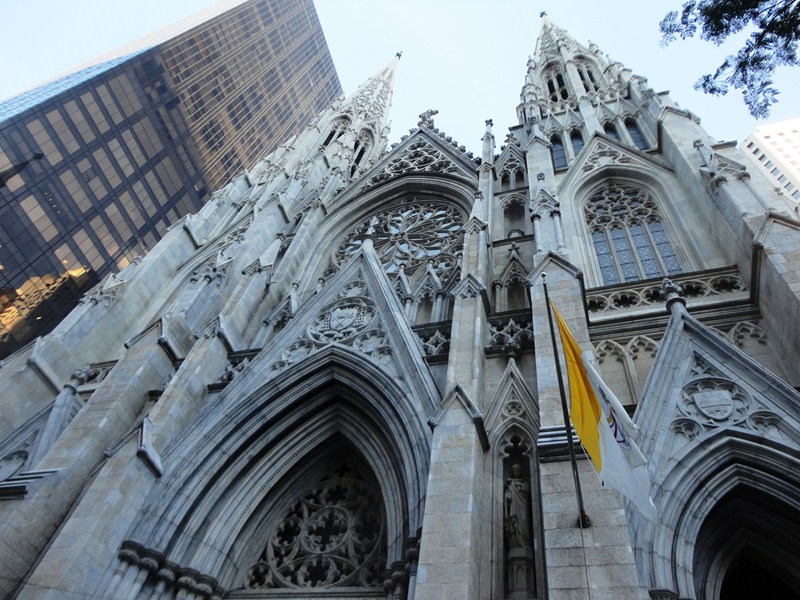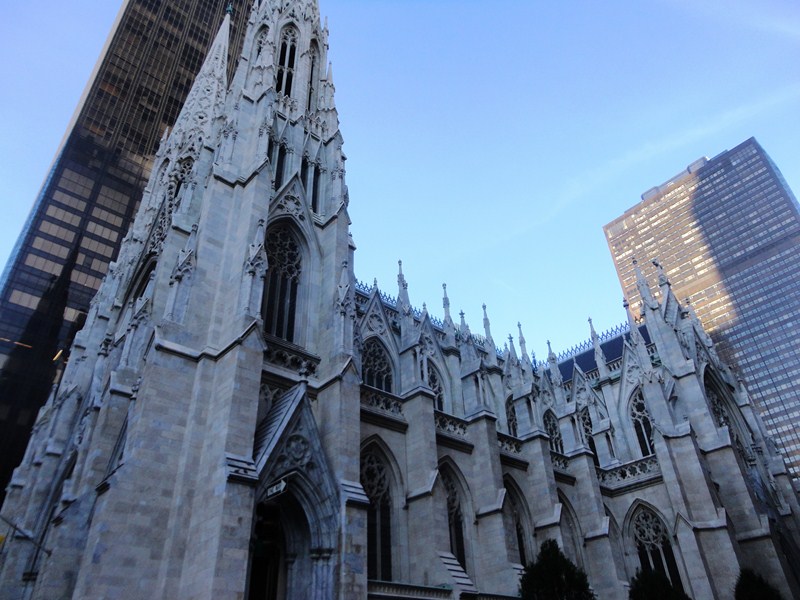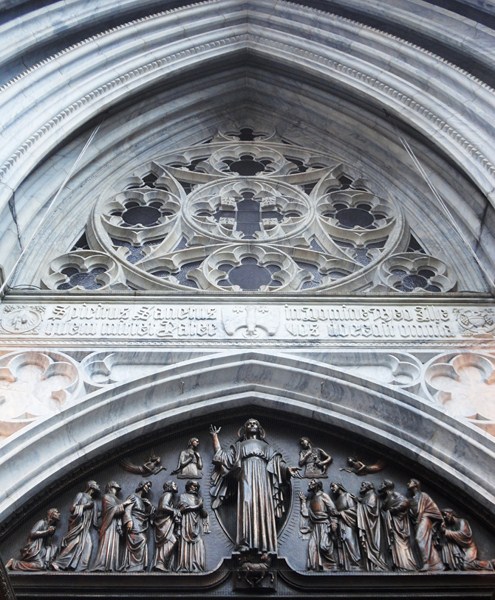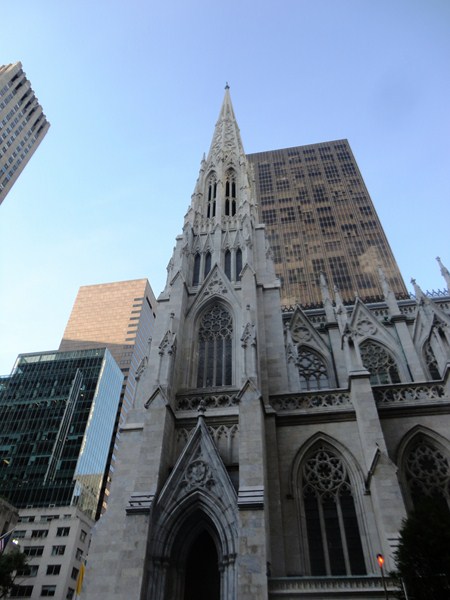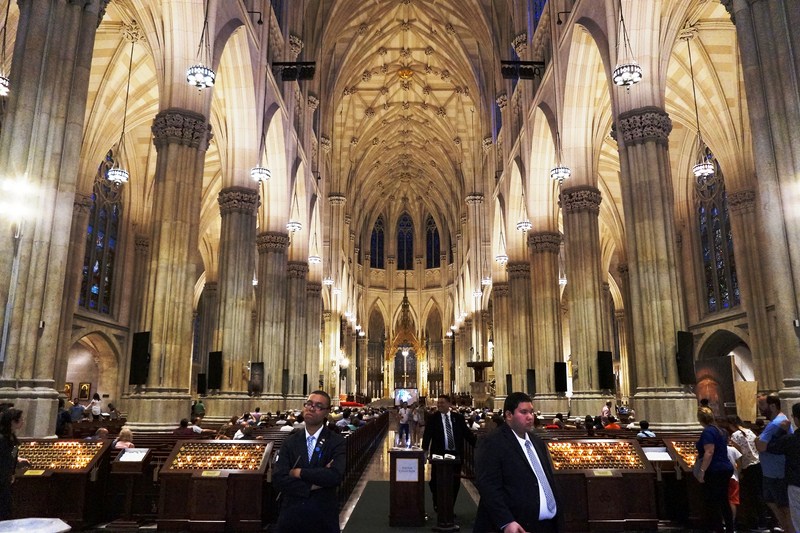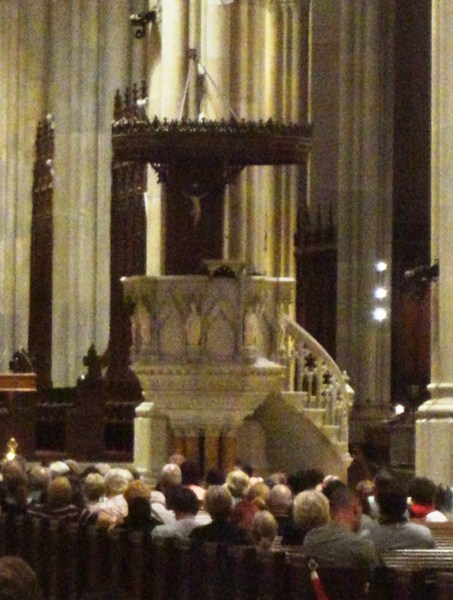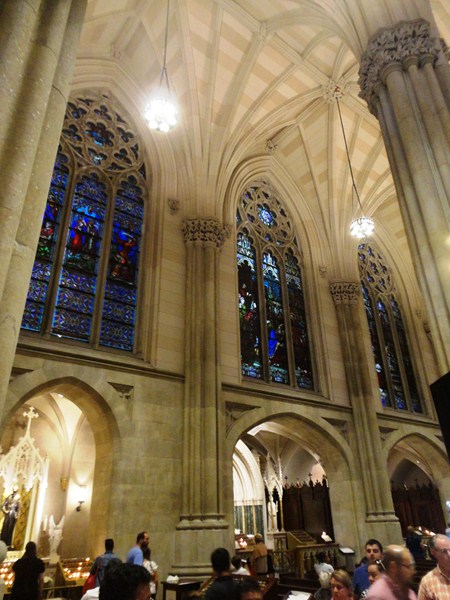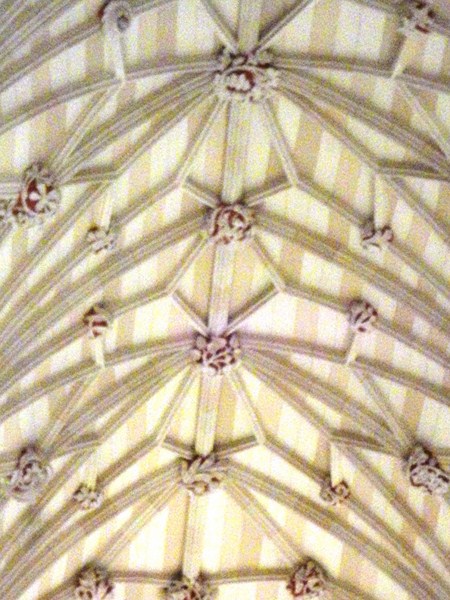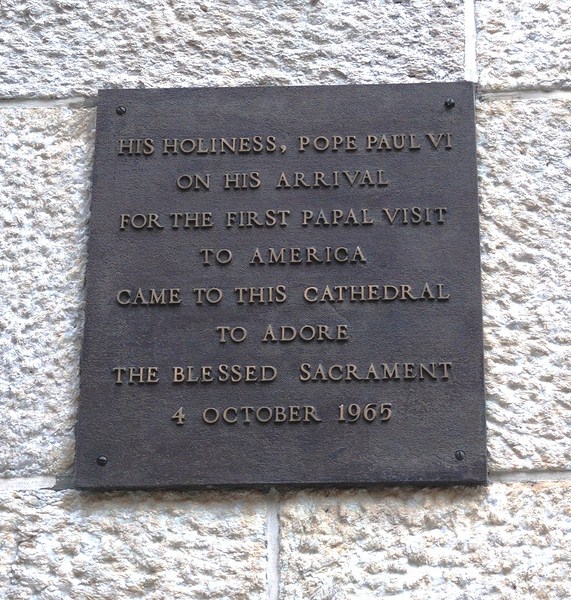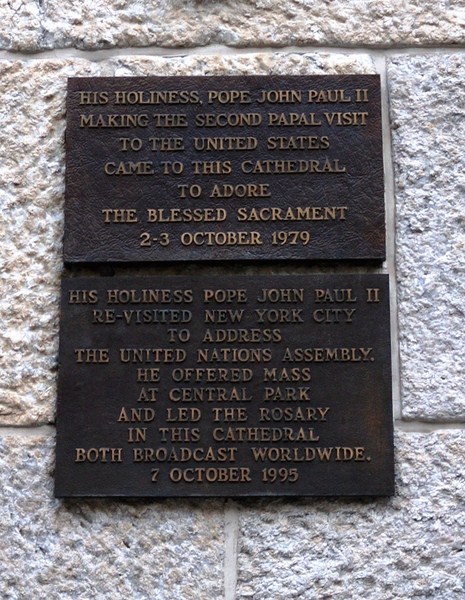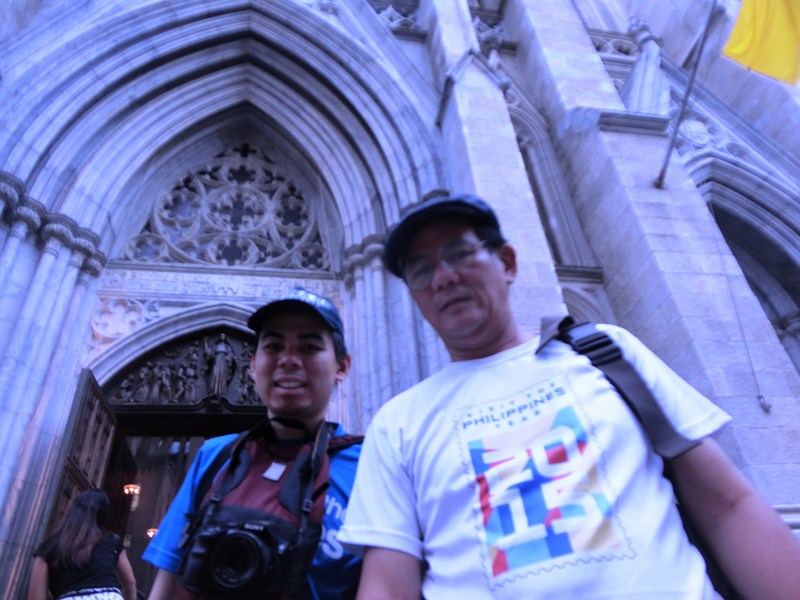Our third, and final, mass in the U.S. was held at the decorated Gothic Revival-style Cathedral of St. Patrick (commonly called St. Patrick’s Cathedral), the seat of the archbishop of the Roman Catholic Archdiocese of New York (created in 1808 and made into an archdiocese by Pope Pius IX on July 19, 1850). Held on the first Friday of July, this was our second visit to the cathedral (the first was 13 days ago) and we attended this mass to pray for a safe journey back to Manila, our flight back being just 8 hours away.
The cathedral is located on the east side of Fifth Avenue, between 50th and 51st Streets in Midtown Manhattan. Directly across the street is the Rockefeller Center and it specifically faces the Atlas statue. A prominent landmark of New York City, the land on which the present cathedral sits was purchased in 1810 and it was designed by James Renwick, Jr. In 1976, the cathedral and its associated buildings were declared a National Historic Landmark.
Here’s some interesting trivia regarding St. Patrick’s Cathedral:
- It is the largest decorated Neo-Gothic-style Catholic cathedral in North America.
- The cathedral can accommodate 3,000 people
- It is built of brick clad in marble quarried in Massachusetts and New York.
- It takes up a whole city block, between 50th and 51st streets, Madison Avenue and Fifth Avenue.
- At the transepts it is 53 m. (174 ft.) wide and 101.2 m. (332 ft.) long.
- The spires rise 100.6 m. (330 ft.) from street level.
- The slate for the roof came from Monson, Maine.
- The windows were made by artists in Boston, Massachusetts and European artists from Chartres, France and Birmingham, England.
- Charles Connick created the rose window.
- The Saint Elizabeth altar was designed by Roman artist Paolo Medici.
- The Saint John Baptist de la Salle altar, one of the few original side-chapel altars, was sculpted by Dominic Borgia. The Papal bull is featured in the adjoining stained-glass window.
- The Saint Louis and the Saint Michael altar was designed by Tiffany & Co.
- The Pietà, sculpted by William Ordway Partridge, is three times larger than Michelangelo’s Pietà.
- In 1893, the cathedral’s Stations of the Cross won artistry prize at Chicago’s World’s Columbian Exposition.
- Pope John Paul IIbust, commemorating his visit to the city in 1979, is located in the rear of the cathedral.
St. Patrick’s Cathedral currently has two pipe organs, both built by the firm of George Kilgen & Son of St. Louis, Missouri. They consist of more than 9,000 pipes, 206 stops, 150 ranks and 10 divisions.
The Gallery Organ, located in the Choir Gallery below the Rose Window over the Fifth Avenue entrance and in the Triforium, near the South Transept, was edicated on February 11, 1930. It took 3 years to build at a cost of US$250,000. Designed by Robert J. Reiley, consulting architect of the Cathedral, it has one of the nation’s most glorious wood facades and is adorned with angels and Latin inscriptions. Containing 7,855 pipes, ranging in length from 32 ft. to 1/2 inch, its longest pipes run horizontally across the North and South Triforia.
The Chancell Organ, located in the North Ambulatory next to the Chapel of St. Joseph, was dedicated on January 30, 1928. It has 1,480 pipes; located on the opposite side of the Ambulatory, diagonally across from the console, and is encased in a carved oak screen ornamented with Gothic elements of design and symbolism.
Here is a timeline of the cathedral’s construction:
- On August 15, 1858, the cornerstone was laid, just south of the diocese’s orphanage.
- Work began that same year, was halted during the Civil War,and resumed in 1865.
- In 1878, the cathedral was completed and was dedicated on May 25, 1879.
- In 1879, the cathedral’s first organ, composed of 4 manuals with 51 stops and 56 ranks, was built by George Jardine & Son, one of New York’s most distinguished organ builders, and installed.
- In 1880, the archbishop’s house and rectory were, both by James Renwick, Jr.
- In 1880, an organ by J.H. & C.S. Odell (then also from New York City), composed of 2 manuals with 20 stops and 23 ranks, was installed in the chancel.
- An adjacent school, no longer in existence, was opened in 1882.
- The spires were added in 1888, and at 329 feet and 6 inches (100.4 meters) were the tallest structures in New York City and the second highest in the United States.
- From 1901 to 1906, an addition on the east, including a Lady chapel (designed by Charles T. Matthews), was constructed.
- Between 1912 and 1930, the Lady Chapel’s stained-glass windows were made by English stained glass artist and designer Paul Vincent Woodroffe.
- In 1927 and 1931, the cathedral was renovated, the sanctuary was enlarged and two great organs were installed.
- In the late 1930s and early 1940s, the cathedral’s main altar area was renovated under the guidance of Archbishop (and later cardinal) Francis Spellman. The previous high altar and reredoswere removed (now located in the University Church of Fordham University). New items include the sanctuary bronze baldachin and the rose stained glass window.
- In the 1940s and 1950s tonal changes were made on the two organs.
- In the 1970s and 1980s, additional renovations were made on the organs by Jack Steinkampf of Yonkers, New York, particularly in the revoicing of flutes and reeds, and the addition of the Trumpette en Chamade.
- In the 1980s, the altar was further renovated, under the direction of Cardinal John Joseph O’Connor. To be more visible to the congregation, a stone altar was built from sections of the side altars and added to the middle of the sanctuary. However, in 2013, this altar was removed.
- In 1993, the organs underwent major restoration. new consoles for both the Gallery and Chancel Organs to replace the original ones (which had deteriorated beyond repair) were acquired. Robert Turner (of Hacienda Heights, California) constructed twin, 5-manual consoles while Solid State Logic, Ltd. of England designed and engineered the combination action. Fiber-optic wiring were used to enable both consoles to control the Gallery, Chancel and Nave Organs at the same time. In 1993, the Gallery console was finished and installed in time for Christmas Midnight Mass. In early 1994, the Chancel console was installed. In 1995, the entire Chancel Organ was restored
- On September 15, 2007, the 10th anniversary of the organ’s renovation, the organs were blessed. The Bicentennial Concert Series was also inaugurated with a performance James E. Goettsche, the Vatican Organist.
- In 2012, an extensive US$177 million restoration of the cathedral was begun and lasted 3 years. The exterior marble was cleaned, the stained glass windows were repaired and the ceiling was painted, among many restorations. On September 17, 2015, the restoration was completed before Pope Francis visited the cathedral on September 24 and 25, 2015.
Beneath the high altar is a crypt in which the nine past deceased Archbishops of New York as well as notable Catholic figures that served the Archdiocese are entombed. They include:
- Archbishop John Joseph Hughes – interred in 1883
- John Cardinal McCloskey – interred in 1885
- Archbishop Michael Augustine Corrigan – interred in 1902
- John Murphy Cardinal Farley– interred in 1918
- Patrick Joseph Cardinal Hayes – interred in 1938
- Francis Joseph Cardinal Spellman – interred in 1967
- Terence James Cardinal Cooke – interred in 1983, declared by Cardinal O’Connor to be servants of God, a step in process of being declared a saint of the Catholic Church
- John Joseph Cardinal O’Connor – interred in 2000
- Edward Michael Cardinal Egan – interred in 2015
- Michael J. Lavelle (Cathedral Rector and Vicar General) – interred in 1939
- Joseph F. Flannelly (Auxiliary Bishop, 1948–1969) – interred in 1973
- Fulton J. Sheen (Auxiliary Bishop, 1951–1965, later bishop of Rochester) – interred in 1979, he was declared venerable by Pope Benedict XVI on June 28, 2012.
- John Maguire (Coadjutor Archbishop, 1965–1980) – interred in 1989
- Pierre Toussaint– interred in 1990, declared by Cardinal O’Connor to be servants of God. In 1996, Toussaint was declared venerable by Pope John Paul II
The galeros of Cardinals McCloskey, Farley, Hayes and Spellman (also worn by Pope Pius XII, as Cardinal Eugenio Pacelli, until the latter’s election to the papacy at the 1939 Papal conclave) are located high above the crypt at the back of the sanctuary. In 1965, the ceremony of the consistory was revised by Pope Paul VI and therefore no galero was presented to Cardinal Cooke or any of his successors.
Requiem Masses were said at the cathedral for the following notable people:
- Babe Ruth (New York Yankees great),
- Roger Maris (New York Yankees great)
- Billy Martin (New York Yankees great)
- Vince Lombardi (legendary football coach)
- Celia Cruz (singer)
- Ed Sullivan (entertainer and host)
- George M. Cohan (actor and dancer)
- Robert F. Kennedy (former Attorney General and Senator from New York)
- Wellington Mara (New York Giants owner)
- Hugh Carey (former Governor of New York)
Special memorial Masses were also held at the cathedral for the following:
- Andy Warhol (artist)
- Joe DiMaggio (baseball player)
- William F. Buckley, Jr. (noted author)
The cathedral or parts of it were featured in a number of movies, TV shows, songs and literary works:
- The climax of Beneath the Planet of the Apes (1970), where Taylor destroyed Earth with the Alpha–Omega bomb, were set in the cathedral’s underground ruins. Centuries earlier, mutant humans surviving a nuclear holocaust founded a religion on the bomb (later depicted in Battle for the Planet of the Apes). They reconsecrated the cathedral to their new religion and installed the bomb in front of the organ pipes in place of the crucifix.
- The TV show Futurama, Fry, Leela, et al. are visiting the sewer mutants beneath the ruins of Old New York and Fry sticks his head in the cathedral, sees the bomb, and says, “So you guys worship an unexploded atomic bomb?” A mutant replies, “Not really, it’s mostly a Christmas and Easter thing.”
- Nelson DeMille‘s 1981 novel, Cathedral, concerning a fictional seizure and threatened destruction of the cathedral by members of the Irish Republican Army on St. Patrick’s Day, is mostly set in and around the cathedral and details of the cathedral’s structure contribute important elements to the plot.
- The cathedral is also featured in the 1990 film Gremlins 2: The New Batch.
- In Giannina Braschi‘s novel, Empire of Dreams (1994), the ringing of the church bells at the cathedral marks a pastoral revolution in New York City.
- The cathedral was referenced in the song Not A Love Story by musical-theatre songwriters Kait Kerrigan and Brian Lowdermilk.
St. Patrick’s Catheral: 5th Ave, New York, NY 10022, USA.

